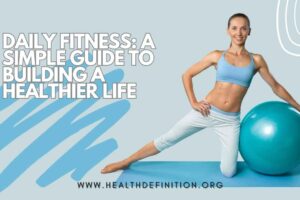
The benefit of Lifelong Physical Activity of Most people think about exercising, they imagine toned muscles, weight‑loss goals, or squeezing in a few workouts before summer. Yet the true, compounded reward of staying physically active year after year is far more profound: lifelong physical activity fortifies your resilience, physiological and psychological, giving you a body and mind that bend without breaking. This article unpacks exactly how maintaining movement throughout all life stages cultivates that resilience, why it matters for modern lifestyles, and how you can harness it starting today.
Resilience: The Hidden Master Benefit
“Resilience” describes your capacity to withstand stressors—Benefit of Lifelong anything from a grueling project deadline to an unexpected fall on an icy sidewalk—and to recover quickly afterward. Lifelong physical activity:
-
Toughens bodily systems (muscles, bones, cardiovascular network, immune function) so they endure bigger challenges with less wear and tear.
-
Strengthens mental stamina by refining neurochemical circuits that govern mood, focus, and stress response.
-
Creates a feedback loop: the more resilient you feel, the more likely you are to stay active, compounding gains even into advanced age.
Let’s break down each layer of this master benefit.
Physical Resilience: Armor for Everyday Life
2.1 Muscular & Skeletal Integrity
Weight‑bearing movement stimulates muscle fibers and bone‑building cells (osteoblasts). Over decades, the Benefit of Lifelong you bank higher bone mineral density and maintain lean mass, drastically cutting the risk of osteoporosis or sarcopenia. Stronger muscles also guard joints, reducing the chances of arthritis flares and injury when you twist, lift, or sprint after an escaping toddler.
Action tip: Combine strength training (two to three sessions weekly) with power movements—think jump‑squats or kettlebell swings—to reinforce slow and fast‑twitch fibers.

2.2 Cardiometabolic Durability
Regular aerobic workouts upgrade your heart’s stroke volume, lower resting blood pressure, Benefit of Lifelong and improve insulin sensitivity. That safeguards you against cardiovascular disease and type 2 diabetes, two leading causes of premature death globally. Bonus: a flexible, high‑capacity cardiovascular system lets you sprint for a bus or hike a steep trail without feeling like your lungs might burst.
Action tip: Rotate moderate steady‑state cardio (brisk walking, cycling) with high‑intensity intervals for maximal adaptation and boredom‑proof programming.
2.3 Immune Fortification
Moderate, consistent exercise mobilizes “immunosurveillance,” the Benefit of Lifelong cells that patrol and neutralize pathogens or rogue cancer cells. Studies show active older adults possess immune profiles resembling much younger cohorts, meaning fewer sick days and more reliable energy.
Action tip: Keep hard training days balanced with recovery—overtraining can briefly suppress immunity.
Physical activity also plays a crucial role in maintaining muscle mass, bone density, and joint flexibility. As we age, the risk of osteoporosis, arthritis, and frailty increases, but consistent exercise helps mitigate these issues. It enhances strength and balance, reducing the likelihood of falls and injuries, which helps individuals maintain independence and perform daily activities with ease.
Mental Resilience: Wiring a Stress‑Proof Brain
3.1 Neurochemical Harmony
Exercise triggers the release of brain‑derived neurotrophic factor (BDNF), serotonin, and dopamine—molecules that brighten mood, sharpen cognition, and heighten motivation. Over the years, these surges strengthen neural networks that buffer against depression, anxiety, and age‑related cognitive decline.
Fact nugget: Lifelong runners show up to 50 % slower hippocampal shrinkage, preserving memory and learning capacity well into their 70s.
Moreover, studies show that lifelong physical activity can extend life expectancy. Active individuals tend to live longer and have a higher quality of life, as exercise combats the development of chronic diseases and promotes general health. Importantly, even starting later in life can bring significant improvements in health and longevity, underscoring the importance of forming a lifelong habit.
In essence, lifelong physical activity is not just about staying fit; it’s about investing in a longer, healthier, and more independent life, with both physical and mental benefits that accumulate over time.
3.2 Grit & Self‑Efficacy
Completing challenging workouts teaches your nervous system a simple lesson: “I can do hard things.” That sense of mastery bleeds into professional, academic, and personal arenas. People who exercise regularly Benefit of Lifelong l[preport higher self‑esteem and are more likely to set and hit stretch goals outside the gym.

3.3 Stress Response Calibration
Chronic stress floods your bloodstream with cortisol; unchecked, it sabotages sleep, weight, and mood. Physical activity acts like a biological stress rehearsal, temporarily elevating heart rate and cortisol, but, crucially, guiding it back to baseline faster. Over the decades, your hypothalamic‑pituitary‑adrenal axis becomes a well‑oiled machine, keeping daily pressures in perspective.
Furthermore, lifelong physical activity is essential for preserving muscle mass, bone density, and joint flexibility. As we age, the risk of conditions like osteoporosis, arthritis, and frailty increases, but regular exercise can help delay or even prevent these issues, keeping the body strong, mobile, and less prone to injury. Maintaining strength and balance through exercise also contributes to greater independence in older age, allowing individuals to perform daily tasks with ease and reducing the risk of falls and accidents.
Social & Functional Spillovers
4.1 Maintaining Independence
A resilient body lets you carry groceries, climb stairs, or play with grandchildren unaided. That autonomy preserves dignity, saves healthcare costs, and fosters richer relationships.
4.2 Community & Support Networks
Joining running clubs, pickleball leagues, or dance classes embeds you in communities. The benefit of Lifelong Social connection itself predicts longevity; exercise is the glue that holds those circles together years—or even decades—later.
4.3 Productivity Amplifier
Regular movers enjoy sharper focus, reduced absenteeism, and higher creativity. Employers increasingly recognize this, offering wellness stipends or onsite gyms not just for perks, but for measurable bottom‑line gains.
Lifelong physical activity is key to maintaining overall health and well-being throughout life. Engaging in regular exercise—from childhood into older adulthood—provides a wide range of benefits that go beyond just physical appearance or performance. One of the most important benefits is improved cardiovascular health, as exercise strengthens the heart and helps regulate blood pressure, significantly reducing the risk of heart disease, stroke, and other cardiovascular conditions.
How to Cultivate Lifelong Activity—No Matter Your Starting Point
-
Adopt a “movement mindset.” View exercise as non‑negotiable hygiene for body and brain, akin to brushing teeth.
-
Periodize across decades. Your 20‑something self may chase personal bests; your 60‑something self may emphasize mobility and balance drills. Both count.
-
Blend modalities. Cardiovascular, strength, mobility, and skill‑based sports each stress the body differently, yielding broader adaptation and preventing plateaus.
-
Track minimums, celebrate streaks. The World Health Organization suggests 150–300 minutes of moderate-to-vigorous activity weekly. Use wearables or simple logs; streaks build identity.
-
Honor recovery. Sleep 7–9 hours, Benefit of Lifelong consumption of protein‑rich meals, and integrate mindfulness to let resilience materialize.
-
Stay curious and playful. Try slacklining, paddleboarding, and Afro‑Caribbean dance—novel skills spark neuroplasticity and keep boredom at bay.
Aging is unavoidable, but frailty is negotiable. Benefit of Lifelong By weaving physical activity through every life season, you’re not just banking stronger muscles or a lower resting heart rate—you’re constructing a resilient self capable of meeting life’s inevitable surprises with confidence and grace. Start where you are, move a little more today than yesterday, and watch resilience compound into an unshakable asset for the rest of your life.

Conclusion
Lifelong physical activity is a cornerstone of maintaining both physical and mental health throughout the aging process. The benefits are far-reaching, from improving cardiovascular health and boosting mental well-being to preserving muscle mass, bone density, and independence as we age. Regular exercise not only reduces the risk of chronic diseases but also enhances longevity and quality of life. Whether you begin early or start later in life, the positive effects of consistent movement are undeniable and transformative. Ultimately, making physical activity a lifelong commitment is one of the best investments you can make for your long-term health and vitality.
FAQs about “What is one benefit of lifelong physical activity
What’s one overwhelming health benefit of staying active for life?
Consistent movement keeps your cardiovascular system strong, reducing the long‑term risk of heart disease, stroke, and high blood pressure.
Does lifelong exercise only help my heart, or does it impact mental health too?
Regular activity stimulates brain‑derived neurotrophic Benefit of Lifelong factor (BDNF) and endorphins, which improve mood, memory, and lower the lifetime risk of depression and cognitive decline.
How does being active throughout life affect aging and independence?
It preserves muscle mass, bone density, balance, and joint flexibility, all of which delay frailty and help Benefit of Lifelong older adults maintain independence in daily tasks.
Can lifelong physical activity help me live longer?
Yes. Large cohort studies show that adults who meet recommended activity levels have a 20–35 % lower risk of premature death compared to sedentary peers.
What if I start late—do the benefits still apply?
Absolutely. Research shows that even people who take up regular exercise in mid‑ or later life can gain significant cardiovascular and metabolic benefits within months and reduce mortality risk over the ensuing years.
Bullet point about the benefits of lifelong physical activity
-
Improves cardiovascular health: Regular physical activity strengthens the heart, reducing the risk of heart disease, stroke, and high blood pressure.
-
Enhances mental well-being: Exercise boosts mood, reduces stress, and helps prevent depression and cognitive decline.
-
Increases longevity: Active individuals have a lower risk of premature death and live longer, healthier lives.
-
Maintains muscle and bone health: Lifelong exercise preserves muscle mass, bone density, and joint mobility, delaying frailty and improving balance.
-
Promotes independence as you age: Staying active supports physical functionality, helping older adults maintain independence in daily life.






